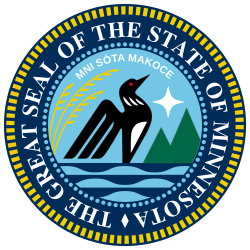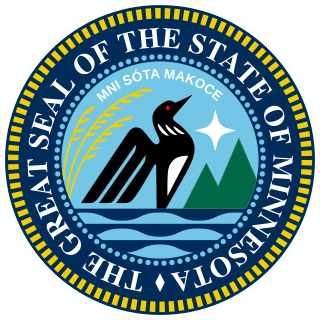Minnesota Legislature
Legislative branch of the state government of Minnesota From Wikipedia, the free encyclopedia
The Minnesota Legislature is the bicameral legislature of the U.S. state of Minnesota consisting of two houses: the Senate and the House of Representatives. Senators are elected from 67 single-member districts. In order to account for decennial redistricting, members run for one two-year term and two four-year terms each decade. They are elected for four-year terms in years ending in 2 and 6, and for two-year terms in years ending in 0. Representatives are elected for two-year terms from 134 single-member districts formed by dividing the 67 senate districts in half (ie. Senate District 1 Contains House Districts 1A and 1B).
Minnesota Legislature | |
|---|---|
| 94th Minnesota Legislature | |
 | |
| Type | |
| Type | |
| Houses | Senate House of Representatives |
Term limits | None |
| Leadership | |
| Structure | |
| Seats | 201 (67 senators, 134 representatives) |
 | |
Senate political groups |
|
 | |
House of Representatives political groups |
|
| Elections | |
Last Senate election | November 8, 2022 |
Last House of Representatives election | November 5, 2024 |
| Meeting place | |
 | |
| Minnesota State Capitol Saint Paul | |
| Website | |
| www | |
| Constitution | |
| Constitution of Minnesota | |
Both houses of the legislature meet between January and the first Monday following the third Saturday in May each year, not to exceed 120 legislative days per biennium. Floor sessions are held in the Minnesota State Capitol in Saint Paul.
History
Summarize
Perspective
City charters
Early on in Minnesota's history, the legislature had direct control over the city charters that set the groundwork for governments in municipalities across the state. In the early period, many laws were written for specific cities. The practice was outlawed in 1881, though attempts were still made.[1] For instance, the long-standing Minneapolis Park and Recreation Board and the city's now defunct Library Board were both created by the legislature in the next several years.[2][3] The Minnesota Constitution was amended in 1896 to give cities direct control over their own charters.[1]
Early female legislators
Following the ratification of the Nineteenth Amendment to the United States Constitution in 1920, women began to be elected to the Minnesota Legislature. In 1922, Mabeth Hurd Paige, Hannah Kempfer, Sue Metzger Dickey Hough and Myrtle Cain were elected to the Minnesota House of Representatives.[4]
In 1984, the legislature ordered that all gender-specific pronouns be removed from the state laws. After two years of work, the rewritten laws were adopted.[5] Only 301 of 20,000 pronouns were feminine. "His" was changed 10,000 times and "he" was changed 6,000 times.[6]
The nonpartisan era
From 1913 until the mid-1970s, Minnesota legislators were elected on nonpartisan ballots. This was a historical accident that occurred when a bill to provide for no-party elections of judges, city, and county officers was amended to include the legislature in the belief that it would kill the bill.[7] While Minnesota legislators were elected on a nonpartisan ballot, they caucused as "Liberals" or "Conservatives," roughly the equivalent in most years to Democratic or Farmer–Labor (later Democratic–Farmer–Labor) and Republican, respectively.[8] In 1974, House members again ran with party designation; in 1976, Senate members did the same.[9]
2004
Governor Jesse Ventura advocated the idea of changing the legislature to be unicameral while he was in office, but the concept did not obtain widespread support.[10]
In 2004, the legislature ended its regular session without acting on a majority of the planned legislation, largely due to political divisiveness on a variety of issues ranging from education to same-sex marriage (See same-sex marriage in the United States for related events during the year). A proper budget failed to pass, and major anticipated projects such as the Northstar Corridor commuter rail line were not approved.[11] Governor Tim Pawlenty, an opponent turned advocate of the line, was expected to request a special session but ended up helping the coordination of other funds to continue the development of the line.[12] The lack of action in the 2004 session is said to be one reason why a number of Republican House members lost their seats in the November election. The Democratic–Farmer–Labor (DFL) minority grew from 53 to 66 and the Republican majority was reduced from 81 to 68.[13]
The Senate was not up for election in 2004 so the DFL was able to maintain its five-seat majority in the upper house. One state senator, Sheila Kiscaden of Rochester, was an Independence Party member until December 2005 when she began caucusing with the DFL, although she had been an elected Republican in the past. The DFL majority increased to six senators when Kiscaden announced her re-affiliation with the DFL in preparation to run for lieutenant governor on a ticket with DFLer Kelly Doran.[14]
2005 shutdown
There is a mandatory adjournment date specified in the state constitution: "The legislature shall not meet in regular session, nor in any adjournment thereof, after the first Monday following the third Saturday in May of any year." In 2005, the regular session ended without passage of an overall budget and a special session was subsequently called by Governor Pawlenty.[15] No overall budget passed by the end of the fiscal year on June 30, and much of the government shut down for the first time in the state's history. However, some essential services remained in operation and some departments received funding in legislation.[16] A compromise budget was approved and signed into law two weeks later.[17]
2011 shutdown

The 2011 Minnesota state government shutdown was a government shutdown affecting the U.S. state of Minnesota. The shutdown was the result of a fiscal dispute between the Democratic–Farmer–Labor Party (DFL) Governor Mark Dayton and the Republican-majority Minnesota Legislature, that was not resolved by the constitutional deadline on June 30. The Republican caucuses and their leaders demanded bigger spending cuts, and for the budget shortfall to be met without tax increases, while Dayton demanded some tax increases. The shutdown started at midnight on July 1, and ended after a budget bill was passed and signed on July 20.
During the shutdown all less important parts of the state government, that were not identified as critical services before the shutdown or in several court cases, suspended their operations. Most state government services were identified as critical or otherwise allowed to continue, so as much as 80 percent of state government spending continued. The eventual budget agreement started to form after Governor Dayton announced on July 14 that he would "reluctantly" pass the last proposal of the Republican legislative leadership before the shutdown, but with conditions. The shutdown was disruptive to the government and some Minnesotans, but its ultimate economic impact was minimal. Politically, it could have influenced the Republican electoral defeat in the 2012 state elections, although there were other factors that may have been more important.Recent history
The November 2022 general election saw the DFL maintain the governorship and the state House, while regaining control of the state Senate. This produced the first DFL legislative trifecta since 2014.
In the 2024 election, the Minnesota House was tied with 67 members elected from each major party. After the election of Curtis Johnson was nullified due to a residency challenge, the 2025 session began with a stalemate in the House. For three weeks, the DFL boycotted the session, denying quorum until a power-sharing agreement was reached.[18]
This section needs expansion. You can help by adding to it. (May 2023) |
Television broadcasts
When the legislature is in session, proceedings of both houses are broadcast on television via the Minnesota Channel and also online via the legislature's website. The Minnesota House YouTube channel is “MNHouseInfo.” The Minnesota Senate YouTube Channel is “Minnesota Senate Media Services.”
Gallery
- The State Office Building, where members of the Minnesota House of Representatives have offices, adjacent to the Capitol. Currently under renovation[19]
- Senate Minnesota Senate Building, completed 2015, where members of the Minnesota Senate have offices and hold hearings. Connected to the capitol by tunnel
Notes
References
See also
External links
Wikiwand - on
Seamless Wikipedia browsing. On steroids.



